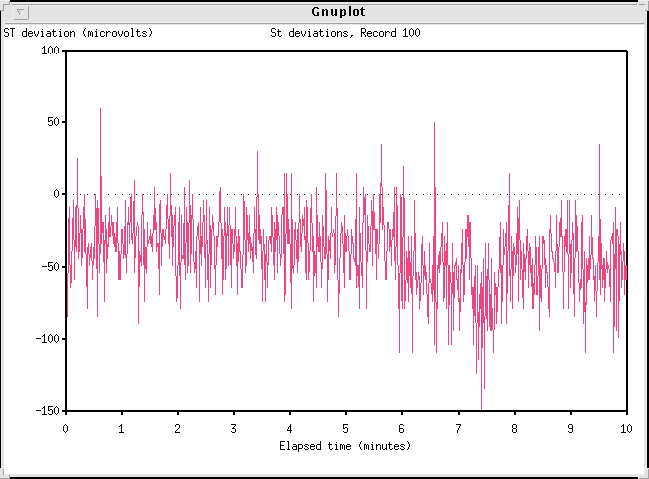We now turn to an extended example showing how an application can be written in C to be used with WAVE. The application is an example only; it is not intended for any serious application, clinical or otherwise. Its structure illustrates, however, how a real application can be built.
As noted in the previous section, changes in the ST segment of the ECG
are of interest because of their relationship to ischemia
(which occurs when the oxygen supplied by the coronary arteries is
insufficient to meet the demands of the myocardium).
Characteristically, ischemia affects the shape of the ST segment,
which corresponds to the first phase of ventricular repolarization
following the QRS complex; typically, the ECG signal may not return
to its baseline, or isoelectric, level (defined in the interval
between the P-wave and the QRS complex) until after the T-wave. The
level of the ST segment relative to the isoelectric level is the ST
deviation. Conventionally, the ST deviation is measured at a single
point 80 milliseconds after the J point (the end of the QRS complex).
An ST deviation of 100 ![]() V is considered to be clinically
significant, and consistent with ischemia.
V is considered to be clinically
significant, and consistent with ischemia.
We will design a program for measuring ST deviations using WAVE. We
assume that the QRS complexes have been marked, and that, in addition,
two special annotations (`(', signifying the beginning of the QRS
complex, and `)', signifying its end) have also been marked for the
first beat that we wish to measure. (To use our program on an
unannotated record, we can use ![]() , and then
insert the special annotations manually around the first beat.)
, and then
insert the special annotations manually around the first beat.)
Let us begin by deciding how the program should be invoked from WAVE. At a minimum, we should be able to specify which signal should be measured, and the region of interest. The program also needs to know the record and annotator names (the latter so that it can read the annotations it needs to get started). Following the conventions used by many other DB applications, we add the following entry to WAVE's menu file:
Measure ST deviation<TAB>stdev -r $RECORD -a $ANNOTATOR \
-f $START -t $END -s $SIGNAL
Here
is the C source for the program. If this looks unfamiliar, read
about how to write DB applications in the
ECG Database Programmer's Guide.
The source for this program is included in the WAVE distribution as stdev.c. Copy this file to the WAVE host if necessary, and compile it in a terminal window using a command such as
cc -o stdev -O stdev.c -ldbDepending on how the DB Software Package has been installed on the WAVE host, you may need to use -I/usr/local/include and -L/usr/local/lib options so that the compiler can locate the *.h files and the DB library. On some systems, the C compiler may have a different name, such as gcc. Consult an expert such as your system administrator if in doubt about compiling a C program with the DB library.
Once the source has been compiled successfully, install the executable binary file stdev in a directory in your PATH. If you are using the C-shell, you may need to run the command rehash to make your shell aware that the program has been installed. Test the program in the terminal window by typing
stdev
which should produce a brief summary of its options. If this test fails, figure out why and correct the problem before continuing.
Once the program has been compiled and installed successfully, try running it from within WAVE. Remember that the annotation file must include the `(' and `)' annotations to mark the beginning and end of the first beat to be measured. Using it on signal 0 of record 100s, with a suitably augmented set of reference annotations, I obtained output beginning with:
0.0171296 -84
0.0306481 -24
0.0437963 -9
0.0569907 -34
0.0701389 -64
0.08375 -59
0.0946296 -49
0.111204 -29
0.125278 -4
0.138796 -59
0.151944 -9
0.164815 -34
(Your output will vary, depending on the exact locations of the `(' and `)' annotations that you insert.)
You can plot this output by piping it to the plot2d command (see plot2d(1), in the ECG Database Applications Guide, for details on plot2d, a command-line preprocessor for gnuplot). To do so, modify the entry in the menu file, so that it becomes:
Plot ST deviation<TAB>stdev -r $RECORD -a $ANNOTATOR \
-f $START -t $END -s $SIGNAL | \
plot2d 0 1 \
-t "ST deviations, Record $RECORD" \
-x "Elapsed time (minutes)" \
-y "ST deviation (microvolts)"
If you now reread the menu and use the new ![]() button, plot2d opens a window with a plot in it, similar to
figure 3.5.
button, plot2d opens a window with a plot in it, similar to
figure 3.5.

Figure 3.5: ST deviations measured by the example program.
(To make this plot, I used the first ten minutes of record 100; the
sample record 100s contains only the first minute of data shown in the
plot.) This window stays open until you dismiss it by pressing
![]() (
( ![]() ) in the Analysis Commands
window; if you forget to do so, the next command you run from the
Analyze window will serve this function (but the command itself won't
run, since plot2d, rather than the command interpreter, will
have read the command string).
) in the Analysis Commands
window; if you forget to do so, the next command you run from the
Analyze window will serve this function (but the command itself won't
run, since plot2d, rather than the command interpreter, will
have read the command string).